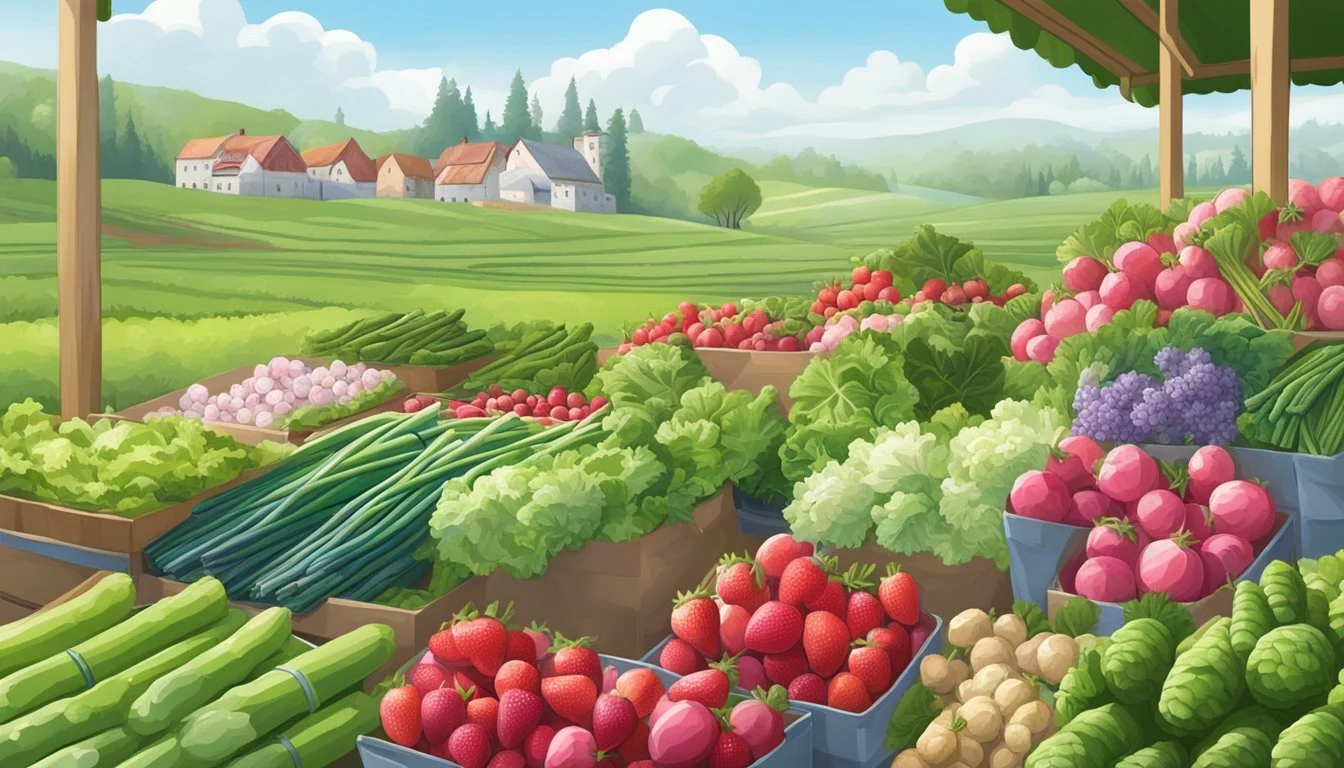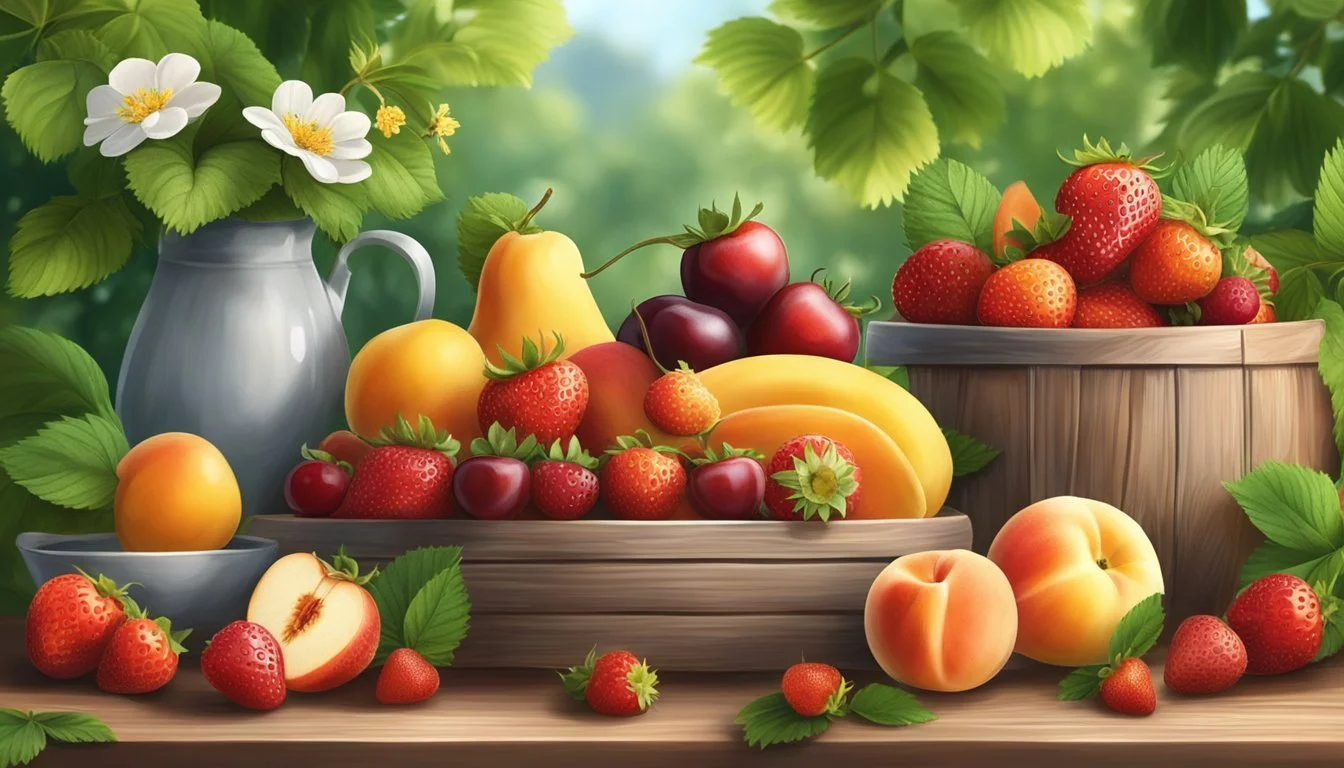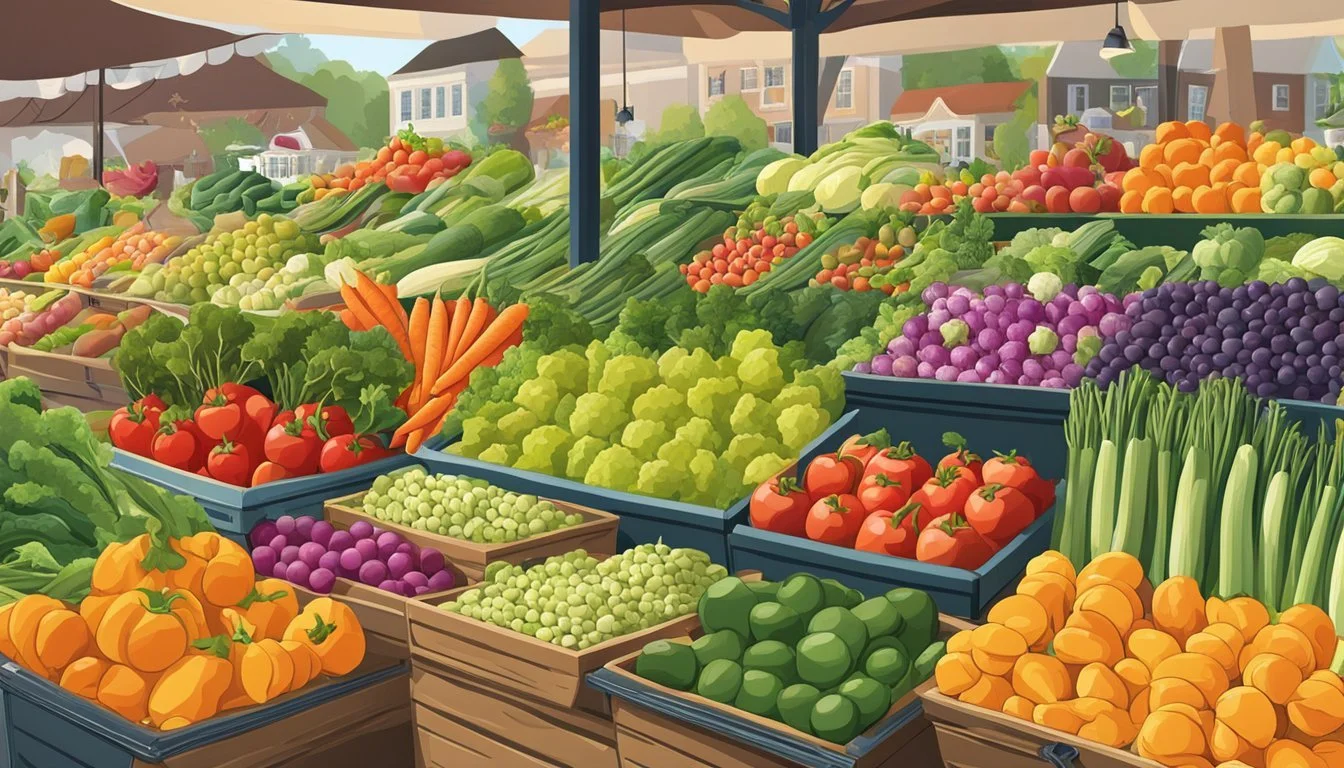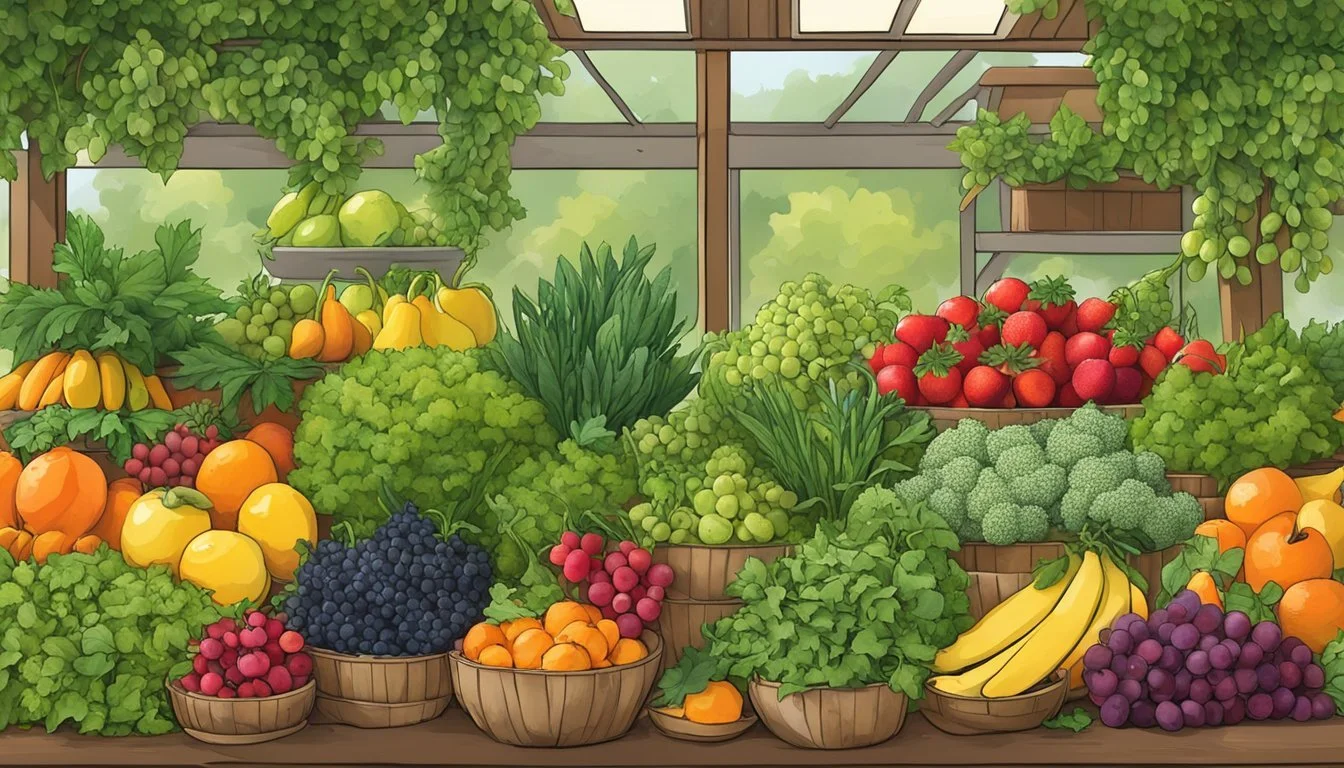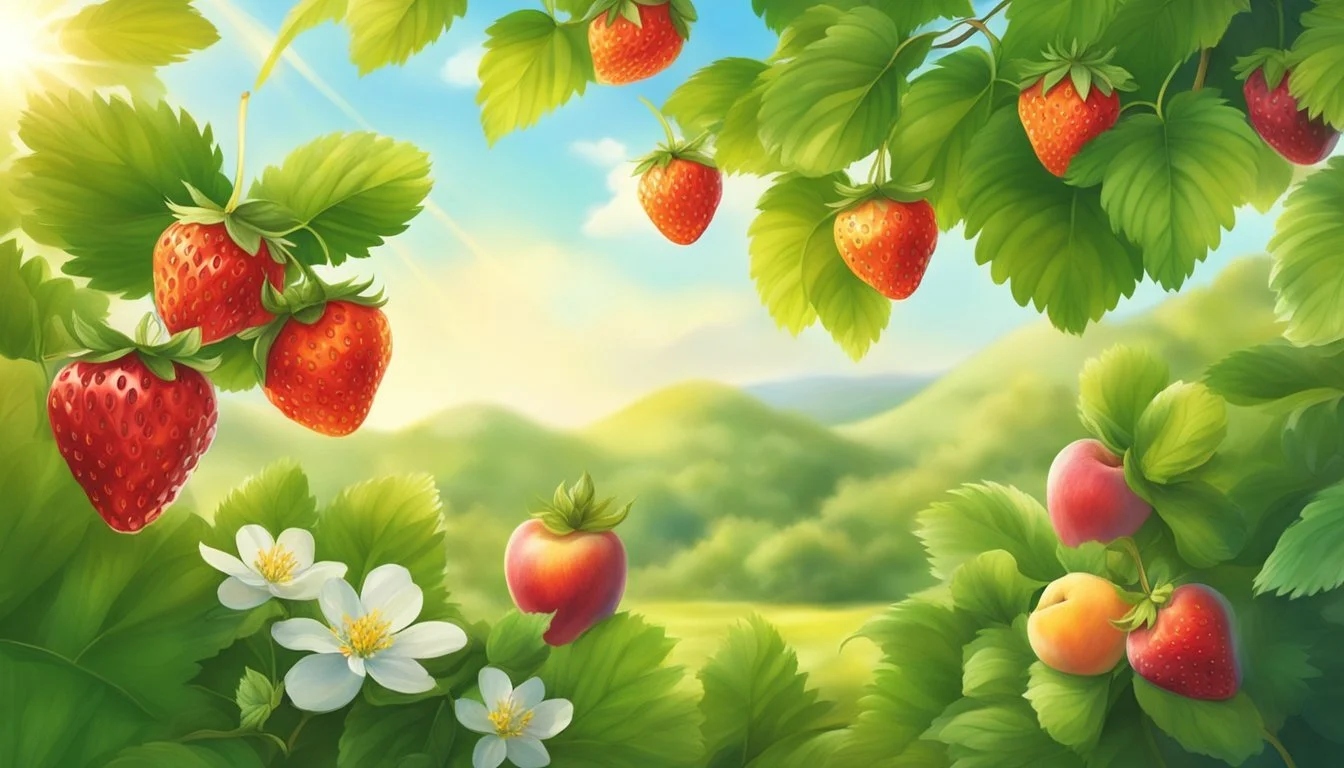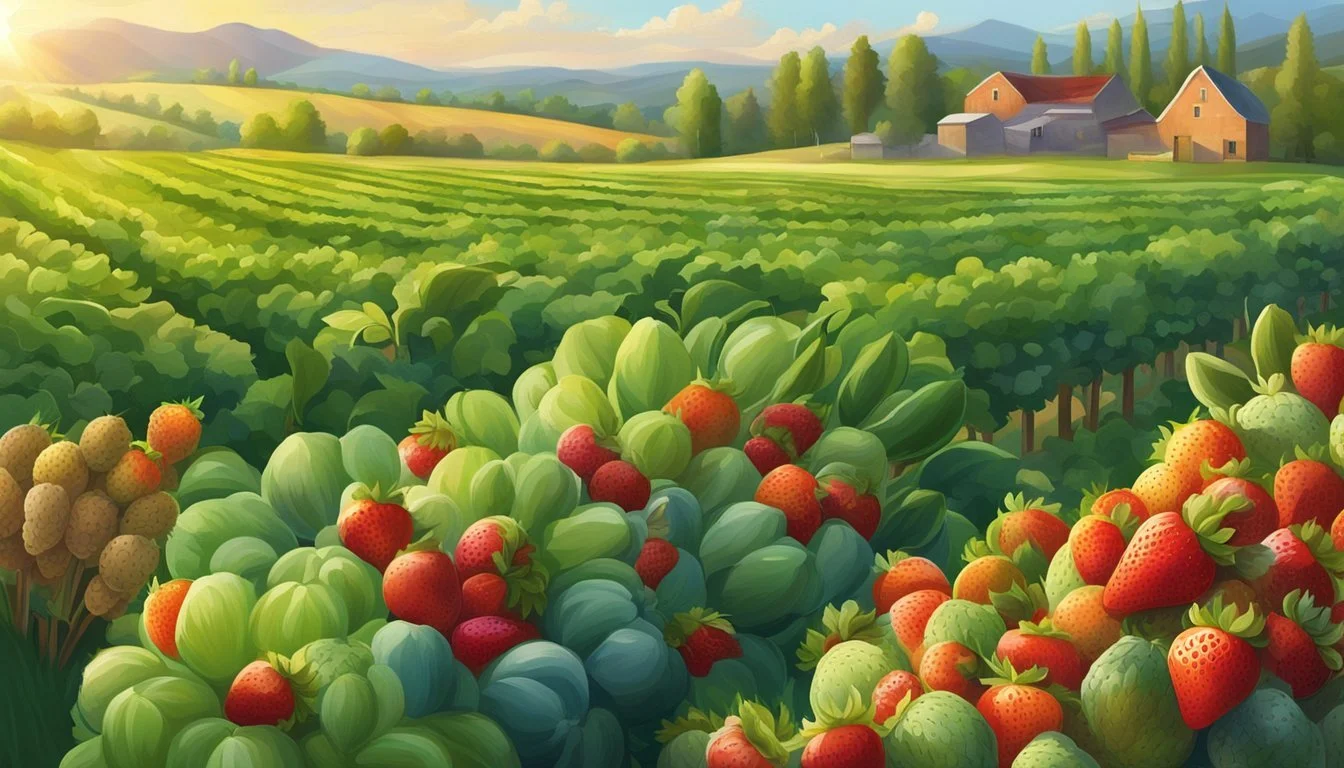Virginia Seasonal Fruit & Vegetables in April
A Guide to Peak Freshness
This Article is Part of our Virginia Seasonal Fruit & Veg Calendar
April in Virginia ushers in a refreshing turn of the seasons, marking a period where the state's fertile lands begin to offer an array of fresh fruits and vegetables. The reawakening of the soil coincides with a surge in agricultural productivity. During this time, the selection of produce in Virginia expands, providing both residents and visitors with a variety of fresh, locally-grown options.
Consumers in Virginia have the opportunity to enjoy produce that is distinctive for its freshness and flavor, largely attributed to the shorter time between harvest and table. Vegetables like asparagus (What wine goes well with asparagus?) begin to peak in April, offering their tender stalks to the market. For fruit enthusiasts, strawberries start to make their sweet, vibrant appearance, signaling the start of the berry season in the region. The convergence of favorable weather and the state's rich agricultural practices make April a month to anticipate for fans of fresh and seasonal produce.
Overview of Virginia's Seasonal Produce
April marks a vibrant transition in Virginia's agricultural calendar, where the state's produce offerings expand significantly due to the arrival of spring.
Spring Season in Virginia
In Virginia, the spring season breathes new life into local farming, bringing forth a bountiful harvest after the cold winter months. Spring weather facilitates the growth of various fruits and vegetables that are not only fresh and flavorful but also nutritionally at their peak.
April's gifts are diverse, including:
Fruits: Apples, Blackberries, Blueberries
Vegetables: Asparagus, Beets (how long do beets last?), Greens/Spinach (What wine goes well with spinach?), Onions, Potatoes
These crops are just starting to come into season, and consumers can begin to enjoy the fresh taste of these local products.
Importance of Seasonality
Emphasizing seasonality in the selection of produce guarantees consumers enjoy fruits and vegetables with optimal taste and nutritional value. In Virginia, this aligns with supporting local farmers and reducing the ecological impact associated with long-distance transportation of off-season goods.
By April, the available seasonal produce includes:
Fruits rich in antioxidants, such as berries.
Vegetables that offer a variety of health benefits; asparagus is high in fiber and folate, while greens like spinach provide iron and calcium.
Consumers can find these seasonal offerings at local markets, contributing to a sustainable and robust food economy within Virginia.
Fruits Available in April
In Virginia, the spring season ushers in a refreshing variety of fruits that are ripe for picking. April, in particular, offers a selection that's not only flavorful but also rich in nutrients.
Strawberries make a vibrant appearance in April, giving consumers a taste of their sweet and tangy profile. These berries are a great source of vitamin C and are versatile in the kitchen, perfect for fresh salads, desserts, or as a snack on their own.
Alongside strawberries, apples continue to be a staple in the seasonal fruit selection. While their harvest begins in late summer, numerous apple varieties have impressive shelf lives and can be found fresh in April due to proper storage methods.
Although less prominent than strawberries and apples, some pear varieties can still be found fresh during this time. They're valued for their soft, buttery texture and are excellent when used in both sweet and savory dishes.
Here is a brief list of April fruits in Virginia:
Strawberries: Fresh and locally sourced.
Apples: Stored varieties with lasting freshness.
Pears: Late-storage varieties available.
These fruits not only bring a taste of spring to the table but also contribute to a healthy diet. They offer a natural sweetness and a range of culinary possibilities, from raw consumption to cooking and baking applications, and are an essential component of Virginia's April produce.
April's Vegetable Bounty
In Virginia, April is a month that heralds the arrival of a fresh selection of vegetables, each adorning the farmer’s markets with their vibrant colors and promising flavors. One of the first to appear is asparagus, a perennial favorite, known for its tender shoots and versatile use in dishes. This is also the time for leeks and onions, which start to thrive and are perfect for adding depth to springtime recipes.
Peas come into their own in April, with both snap peas and snow peas offering a crunch that's characteristic of their fresh, sweet taste. They are joined by beans, another staple that starts to take shape in gardens and on farms. Radishes impart a spicy kick to salads and are an excellent addition to the array of seasonal produce.
Vegetables Description Artichokes (how long do artichokes last?) Hearty and flavorful, they peak in the spring. Rhubarb Technically a vegetable, often used as a fruit. Potatoes New potatoes start appearing, tender and flavorful. Greens A variety includes spinach, lettuce, and kale. (What wine goes well with kale?)
The arrival of artichokes adds a robust option for those seeking a heartier vegetable, while rhubarb, though often paired with sweet fruits in desserts, is ready to be harvested and adds a tart complexity to dishes. Early potatoes also make their debut, bringing with them the earthy taste of new, tender tubers.
The greens of April—such as spinach, kale, and various types of lettuce—emerge too, offering a range of textures and flavors that are a testament to the season's freshness. They lay the foundation for nutritious salads and side dishes that are both healthy and flavorful. Each of these vegetables represents the reawakening of the earth in spring and provides chefs and home cooks with ingredients that inspire creativity in the kitchen.
Herbs and Greens in Season
April in Virginia offers a wide array of fresh herbs (how long do fresh herbs last?) and greens, marking the season where salads and herbal dishes come alive with flavor.
Herbs:
Herb enthusiasts can rejoice as April ushers in an abundance of aromatic options. Parsley and thyme flourish, offering their distinct flavors to a variety of dishes. Mint emerges as a refreshing addition to beverages and desserts. For those who prefer an Italian touch, basil begins to make its appearance, perfect for enhancing pasta (how long does pasta last?) sauces and pizzas.
Basil: Begin to plant
Mint: Ready for harvest
Parsley: Abundant
Thyme: Fragrant and plentiful
Leafy Greens:
Green Status Notes Arugula Peppery bite Ideal for salads Lettuce Tender leaves A staple for fresh salads Kale Nutrient-rich Hardy, with a hearty flavor Spinach Versatile Use in salads and cooked dishes Watercress Peppery flavor Adds a zesty note to meals
Each of these greens offers unique benefits. Spinach and kale, for instance, are packed with vitamins and can be eaten raw or cooked, while watercress may serve as a spicy garnish or an invigorating addition to soups.
Fennel and green onions, often grouped with herbs and greens, come into season, offering their crisp textures and aromatic contributions to springtime dishes. They are frequently used in salads, as garnishes, or as flavor enhancers in a variety of recipes.
Gardeners and chefs alike will find that herbs and leafy greens in Virginia during April provide the freshest ingredients for creative and healthy cooking, embodying the essence of spring's renewal on the plate.
Planning for April Harvest
April in Virginia is a vibrant month for agriculture, marking a transition in the growing seasons with an increase in the availability of various crops. This period is crucial for both gardeners and farmers as it sets the pace for the coming months.
Crop Availability and Planting
April heralds the peak season for asparagus, a perennial favorite, and the beginning of the strawberry season. Both crops demand attention from growers in terms of preparation and planting schedules.
Crops typically available in April include:
Asparagus
Strawberries
Greens (such as kale and spinach)
Spring onions
Farmers should consider crop rotation and soil enrichment strategies to optimize their yields. Utilizing this month's mild weather is key for sowing seeds of summer crops like tomatoes and peppers, under the right protective measures.
Planting tips for farmers and gardeners:
Asparagus: Plant crowns in well-drained soil.
Strawberries: Choose a sunny spot and plant in rows with ample space.
Greens: Sow directly into the ground or start indoors if late frosts are expected.
Farmers Market Expectations
Consumers visiting farmers markets in April can anticipate a robust selection of fresh produce. Farmers market vendors are likely to offer an array of leafy greens and root vegetables alongside the early fruits of the season.
Expect to find at farmers markets:
Greens: Spinach, kale, and salad mixes.
Root Vegetables: Radishes and beets.
Asparagus: Fresh and locally grown.
Strawberries: Beginning of the season's harvest.
Farmers markets are also an excellent place for growers to educate consumers about the importance of seasonal eating and supporting local agriculture. With smart planning and clear communication, both farmers and shoppers can make the most of April's bounty.
Preparing Seasonal Dishes
In April, Virginia's bounty offers a plethora of fresh flavors, ideal for crafting dishes that sing with spring vitality. Chefs and home cooks alike revel in the opportunity to showcase the state's seasonal produce. Here's how to make the most of Virginia's April harvest.
Asparagus stands out for its versatility. For a simple side, one can grill it to smoky perfection or blanch it for a tender bite, finishing with a hint of butter to complement its natural, earthy flavor.
Rhubarb, while often associated with sweet pies, also has culinary uses in savory dishes. Its tartness balances well against rich meats like pork or in a chutney as a contrast to creamy cheeses.
Vegetable Preparation Pairing Radishes Thinly sliced Buttered bread Artichokes Steamed Lemon aioli Young Carrots Roasted Fresh herbs
Seasonal cooking not only emphasizes the flavor but also supports local agriculture. An April table in Virginia could feature spring peas turned into a fresh pea puree, a bed for seared scallops, applying just a hint of butter to highlight their natural sweetness.
Remember, less is more with high-quality ingredients. A dash of seasoning or a pat of butter can be enough to elevate the inherent flavors of these fresh, seasonal vegetables. By focusing on the quality of the produce and simple preparation methods, every dish allows Virginia's April produce to shine.
Virginia's Spring Gardening Tips
April in Virginia is a vibrant month for gardeners. As the state thaws from winter's chill, the soil warms, beckoning a variety of fruits and vegetables to be planted. Gardeners should take advantage of this time by preparing their plots and sowing seeds that thrive in Virginia's spring climate.
They must begin with soil preparation, ensuring it is well-aerated and enriched with compost to promote healthy growth. Early April is also an ideal time to test the soil's pH levels, as most fruits and vegetables prefer a neutral to slightly acidic pH.
Here's a brief guide on what to plant:
Vegetables Planting Dates Lettuce Early April Spinach Early April Peas Early April Radishes Early April Beets Mid-April Carrots Mid-April
Fruit Tips: April is not typically the month for fruit tree planting, which is better done in the fall or early spring. However, gardeners can prune existing fruit trees and berry bushes to invigorate new growth during April.
For optimal results, gardeners should monitor nighttime temperatures and be ready to protect tender seedlings from unexpected late frosts. Using row covers or cold frames can offer an additional layer of security against the chill.
In conclusion, diligent preparation in April sets the stage for a rewarding growing season in Virginia. Gardeners should plan their planting calendar, prepare their soil, and protect early plantings for bountiful harvests in the months to come.
Preserving April's Harvest
In Virginia, the arrival of April marks a period of abundance for a variety of fresh produce. Preservation through canning, freezing, and other methods ensures that these flavors can be enjoyed well beyond their picking season.
Freezing is an excellent preservation method for berries and tender greens that appear in April. Berries should be washed, dried, and spread on a baking sheet to freeze individually before transferring to a sealed container, which helps maintain their individual shapes and textures. Vegetables like asparagus can be blanched for 2-3 minutes, cooled in an ice bath, dried, and then frozen.
Canning can be a delightful way to preserve fruits and vegetables, such as apricots and snap peas. When canning produce, one follows strict sanitary guidelines and uses a water bath or pressure canner to ensure safety and longevity of the food. Homemade jams, jellies, and pickles from April’s harvest can be a joy to create and consume.
Here are guidelines for preserving some of April’s produce:
Produce Freezing Canning Strawberries Wash, dry, freeze on tray Jam, jelly Greens (spinach, lettuce) Blanche, dry, freeze in bags Pickling (limited use) Asparagus Blanche, dry, freeze in bags Pickle or pressure canning
For those interested in long-term storage, root vegetables such as beets and carrots store well in cool, dry places and do not necessarily require immediate preservation methods.
Preservation allows the enjoyment of April’s bounty to extend through the year, encouraging local consumption and reducing food waste. Good practices ensure safety, quality, and a connection to the seasonal rhythms of Virginia’s agricultural output.
Impact of Weather on Produce
In Virginia, the interplay between weather and agricultural output is pronounced during the early spring months. This period is critical for determining the quality and volume of both fruits and vegetables.
Effect of Early Spring Weather
Early spring in Virginia often brings a mixture of warm days and potential frost events, which can significantly affect fruit and vegetable crops. For instance, strawberries are highly sensitive to these conditions; an unseasonably warm period could speed up their ripening, leading to an earlier harvest. Conversely, a late frost may harm the blossoms, resulting in reduced yields.
Warm Days: Encourage early blossoming and growth
Frost Events: Pose a risk of damage to early blossoms
Adjusting for Weather Variations
Farmers in Virginia have developed strategies to cope with weather variations. By employing techniques such as row covers or controlled environments, they provide a level of protection to tender sprouts during unpredictable spring conditions. Furthermore, scheduling planting times and choosing crop varieties that are resilient to local weather patterns are essential steps in compensating for seasonal variations.
Protection Strategies:
Row covers
Controlled environments (greenhouses)
Adaptive Measures:
Staggered planting schedules
Selection of weather-resistant varieties
Beyond April: Looking Ahead
As the calendar progresses beyond April, they witness a vibrant change with Virginia's farms preparing for the bountiful summer harvest. Anticipating the summer produce, one must take note of the gradual introduction of a variety of fruits and vegetables that begin to peak.
Seasonal Transition to Summer
The transition from spring to summer in Virginia is marked by an increase in both temperature and variety of available produce. In May, they start to see an array of fresh produce hit the markets:
Fruits: Strawberries come into full bloom and farmers' markets boast their red, juicy berries.
Vegetables: The greens of spring begin to make way for heartier summer vegetables.
By the time June arrives, the concept of "summer produce" is fully embraced with even more selections:
Fruits: The sweetness of berries continues with the arrival of blueberries and raspberries.
Vegetables: Summer squash, cucumbers, and tomatoes start to make their prominent appearance.
The preparation for the summer harvest doesn't just promise a greater variety but also the heightened flavors that come with fruits and vegetables reaching their optimal growth under the Virginia sun. It's a period of growth and abundance, leading up to some of the most anticipated and flavorful produce of the year.
Conclusion
April in Virginia offers a rich tapestry of fresh produce that not only supports local farmers but provides a variety of healthy options for consumers. The season's bounty includes strawberries, which are at their peak, bursting with flavor and ideal for both culinary use and direct consumption. Root vegetables, such as beets, continue to be a staple, bringing earthy flavors (What wine goes well with earthy flavors?) and vibrant colors to the plate.
Shoppers can also look forward to asparagus, a spring favorite known for its versatility in dishes from salads to entrees. Concurrently, leafy greens like spinach and kale remain abundant, packed with essential nutrients. It is advantageous for individuals to integrate these seasonal vegetables into their diets for both nutritional benefits and to enjoy the freshest flavors available.
Cruciferous vegetables such as broccoli are readily available and offer a multitude of health benefits when consumed regularly. Additionally, certain fruits, like Asian pears and apples, may still be in stock from cold storage, allowing for a wider variety of fresh, crisp options.
Consumers are encouraged to take advantage of the fresh and local produce during this season. They can support Virginia agriculture and maintain a healthy lifestyle by making these fruits and vegetables a part of their daily intake. The use of these seasonal ingredients will not only enhance the flavor of meals but also contribute to the sustainability of local farming communities.

